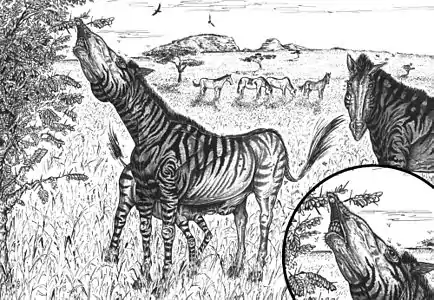Amerhippus
Amerhippus is an extinct South American horse of uncertain taxonomic identity in the genus Equus. It is sometimes classified as a subgenus containing several extinct species of horses that lived in South America, or a single, morphologically variable extinct species Equus neogeus.
| Amerhippus | |
|---|---|
 | |
| Skull of Amerhippus sp. | |
| Scientific classification | |
| Kingdom: | Animalia |
| Phylum: | Chordata |
| Class: | Mammalia |
| Order: | Perissodactyla |
| Family: | Equidae |
| Genus: | Equus |
| Subgenus: | †Amerhippus Hoffstetter, 1950 |
| Type species | |
| †Equus andium Branco, 1883 | |
| Species | |
| |
Description
It lived from 2.588 to 0.012 Mya. It measured roughly 1.5 m (4.9 ft) tall and weighed approximately 400 kg (880 lb).[2]
Distribution
They were one of two groups of equines in South America alongside Hippidion.[3] Fossils have been recovered from the Tarija Formation of Bolivia, the Serranía del Perijá in Venezuela, the Chiu-Chiu Formation of Chile, the Sabana Formation of the Bogotá savanna in Colombia,[4] and from various locations in Ecuador.[2]
Taxonomy
While they have formerly been referred to as belonging to 5 separate species, this has been revised down into three,[5] and more recently a single, morphologically variable species Equus neogeus.[6][7] Equus first appeared in South America during the late Early Pleistocene around 1 Ma.[3] A 2008 study of mitochondrial DNA fragments of a specimen of E. neogeus found it to be nested within mitochondrial lineages of E. caballus.[8] A close relationship to caballine horses was also supported by a 2019 morphological analysis study.[9]
Gallery
.jpg.webp) Statue in Osorno, Chile
Statue in Osorno, Chile Restoration of hippidiforms with grazing Amerhippus in the background
Restoration of hippidiforms with grazing Amerhippus in the background
References
- "Amerhippus". NCBI taxonomy. Bethesda, MD: National Center for Biotechnology Information. Retrieved 17 January 2019.
- Prado, J. L.; Alberdi, M. A. T.; De Reyes, M. N. L.; Poiré, D. G.; Canalicchio, J. M. (2013). "New material of Equus (Amerhippus) neogeus (Mammalia, Perissodactyla) from the late Pleistocene of Olavarría (Argentina)". Neues Jahrbuch für Geologie und Paläontologie - Abhandlungen. 269 (2): 125. doi:10.1127/0077-7749/2013/0340. hdl:10261/115119.
- PRADO, JOSE LUIS; ALBERDI, MARIA TERESA (2018). FOSSIL HORSES OF SOUTH AMERICA : phylogeny, systemics and ecology. SPRINGER INTERNATIONAL PU. doi:10.1007/978-3-319-55877-6. ISBN 978-3-319-85769-5. OCLC 1048948248. S2CID 164732480.
- . 1960. Los Equidos fósiles de la Sabana de Bogotá. Boletín de Geología, Universidad Industrial de Santander 4. 51–78. Accessed 2017-03-30.
- Prado, J. L., and Alberdi, M. T. (2017). Fossil Horses of South America. Springer International Publishing, 150
- Machado, Helena; Grillo, Orlando; Scott, Eric; Avilla, Leonardo (September 2018). "Following the Footsteps of the South American Equus: Are Autopodia Taxonomically Informative?". Journal of Mammalian Evolution. 25 (3): 397–405. doi:10.1007/s10914-017-9389-6. ISSN 1064-7554. S2CID 22113020.
- Machado, Helena; Avilla, Leonardo (2019-07-03). "The Diversity of South American Equus: Did Size Really Matter?". Frontiers in Ecology and Evolution. 7: 235. doi:10.3389/fevo.2019.00235. ISSN 2296-701X.
- Orlando, Ludovic; Male, Dean; Alberdi, Maria Teresa; Prado, Jose Luis; Prieto, Alfredo; Cooper, Alan; Hänni, Catherine (May 2008). "Ancient DNA Clarifies the Evolutionary History of American Late Pleistocene Equids". Journal of Molecular Evolution. 66 (5): 533–538. Bibcode:2008JMolE..66..533O. doi:10.1007/s00239-008-9100-x. ISSN 0022-2844. PMID 18398561. S2CID 19069554.
- Barrón-Ortiz, Christina I.; Avilla, Leonardo S.; Jass, Christopher N.; Bravo-Cuevas, Víctor M.; Machado, Helena; Mothé, Dimila (2019-09-12). "What Is Equus? Reconciling Taxonomy and Phylogenetic Analyses". Frontiers in Ecology and Evolution. 7: 343. doi:10.3389/fevo.2019.00343. ISSN 2296-701X.